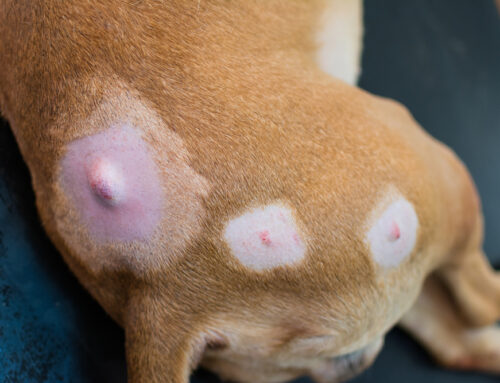Lyme disease is the most commonly diagnosed tick-borne illness in dogs and humans, and now that Spring is well underway here in the south, you need to be aware that ticks are on the move and searching for their next meal. Learn how to keep your pet—and yourself—from becoming their next victim with this Lyme disease guide from your trusted south Austin vet, Oliver Animal Hospital.
Lyme disease transmission in dogs
Lyme disease is caused by Borrelia burgdorferi, a spiral-shaped bacteria transmitted by the black-legged tick or deer tick (i.e., Ixodes scapularis). Infected ticks acquire the bacteria after feeding on reservoir hosts such as mice, grey squirrels, and other rodents. Then, when the tick takes their next blood meal, the bacteria mixes with the tick’s saliva that is injected into the unsuspecting host—your pet.
Once Borrelia burgdorferi reach the bloodstream, the bacteria disseminate throughout the dog’s body and target specific areas, including the joints, nervous system, kidneys, and less commonly, the heart.
Lyme disease in cats
Cats are considered low risk for Lyme disease. Infection has never been reported in a cat outside a laboratory setting, and experts believe cats may be able to clear the bacteria on their own. However, in an abundance of caution, Oliver Animal Hospital recommends that all cats receive year-round flea and tick preventives and that all cat owners understand Lyme disease signs and transmission. Fleas and ticks carry other diseases that can be dangerous for cats, so year-round protection is essential.
Lyme disease signs in dogs
Diagnosing Lyme disease can be baffling, because signs are often vague and easy to mistake for other conditions. Signs may spontaneously come and go and development can take two to five months, making correlating the signs with a known tick bite difficult for owners and veterinarians. In addition, many dogs are completely asymptomatic and show no signs at all.
The 10% of Lyme disease-positive dogs who do show signs may exhibit:
- Shifting leg lameness (e.g., occasionally favoring a different leg)
- Fever
- Stiffness
- Joint swelling
- Decreased activity or lethargy
- Swollen lymph nodes
- Appetite loss
Unlike humans, affected dogs do not develop a bullseye rash or other visible indicator around the tick bite. If your dog is demonstrating any of the above signs, contact your south Austin vet at Oliver Animal Hospital to schedule an examination and testing.
Lyme disease diagnosis in dogs
Dogs with clinical signs should receive immediate veterinary care. In some cases, progressive Lyme disease can result in chronic joint inflammation (i.e., arthritis) or kidney damage, and the latter may lead to renal failure. Lyme disease-positive dogs can also suffer from simultaneous other tick-borne disease infections, such as anaplasmosis or ehrlichiosis, which can complicate treatment and prognosis.
Lyme disease diagnosis relies on clinical examination findings (e.g., swollen lymph nodes, fever), pet history (e.g., at-home behavior, outdoor activities, travel history), and diagnostic testing, to detect Lyme disease antibodies in the blood. Additionally, we may recommend testing, including blood work, urinalysis, and ultrasound, to evaluate your pet’s organ function.
Lyme disease treatment in dogs
Dogs with uncomplicated Lyme disease enjoy a good prognosis. Treatment involves a long (e.g., 30 days) oral antibiotic regimen to eliminate Borrelia burgdorferi bacteria from the pet’s circulation. Although clinical improvement (e.g., better mobility, appetite, energy) may be seen in a few days, owners must continue to give the antibiotics as directed to ensure their pet is completely disease-free. After the medication is complete, dogs are re-tested to ensure they have cleared the Lyme bacteria from their system.
Dogs with complications, such as additional tick-borne illnesses, kidney damage, or chronic arthritis, require additional therapies, medications, and supportive care.
Lyme disease prevention for pets

Year-round tick prevention is the best defense against Lyme disease and other tick-borne pathogens. These medications begin killing ticks after they bite but before disease transmission can occur, which can be approximately 36 to 48 hours, according to the Centers for Disease Control. Many preventives recommended by your trusted south Austin vets feature a rapid speed of kill of less than eight hours.
Additional steps for minimizing tick exposure and Lyme disease risks include:
- Avoiding areas where ticks are common — Ticks are most prevalent during early spring and late fall, although they can be present throughout the year. They prefer shady areas and thick vegetation, especially wooded areas, grassy fields, and areas with abundant wildlife.
- Discouraging ticks and wildlife in outdoor pet spaces — Keep grass trimmed, remove weeds and leafy debris, and relocate wildlife feeders to discourage ticks and tick-carrying mammals and birds where your pet plays or eliminates
- Checking your pet for ticks — Perform a thorough tick check to identify and remove any crawling or attached ticks after spending time outdoors. TIcks prefer to hide in undisturbed areas, such as your pet’s face, ears, armpits, groin, and anal region below the tail.
- Removing attached ticks as soon as possible — Safely remove ticks using tweezers or a tick removal tool. Dispose of the tick by drowning it in isopropyl alcohol, and sealing it in a plastic bag or flushing it down the toilet. Wash your hands thoroughly to reduce exposure risks.
- Screening your dog annually for tick-borne diseases — We recommend yearly screening tests for Lyme disease, ehrlichiosis, and anaplasmosis at your dog’s annual preventive care visit.
As much as we welcome the longer days and warmer weather, we’re not exactly tick-led to see the return of ticks and Lyme disease. Fortunately, the south Austin vets at Oliver Animal Hospital team have the tools and strategies to bite back against these crawling criminals and their harmful pathogens. Contact us to set up your pet’s next appointment.








Leave A Comment